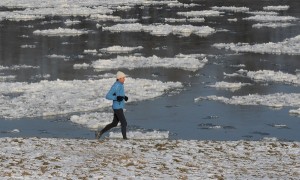
A jogger runs on the banks of the Vistula river covered with ice pieces, in Warsaw, Poland, on Thursday, Feb. 2, 2012. Poland along with Central and Eastern European countries is going through a wave of very low temperatures, with the lowest temperature of minus 32 Celsius, or minus 25.6 Fahrenheit registered early Thursday in Stuposiany, in southeast Poland. AP PHOTO/ALIK KEPLICZ
WARSAW—A cold snap kept Europe in its icy grip on Thursday, pushing the death toll to 160 as countries from Italy to Ukraine struggled to cope with temperatures that plunged to record lows in some places.
Nine more people died in Poland overnight as temperatures hit minus 32 Celsius (minus 25.6 Fahrenheit) in the southwest, bringing the overall toll to 29 since the deep freeze began last week, national police said.
In Ukraine, tens of thousands of people have headed to shelters trying to escape the freeze that the emergencies ministry said has now killed 63 people.
Most of them literally froze to death on the street, with only a handful making it to hospital before succumbing to hypothermia, the ministry said.
Shivering and hungry, tens of thousands of Ukrainians have sought help in the more than 2,000 temporary shelters set up by the authorities to help the poor survive the fearsome spell of cold weather.
The shelters offer warmth and hot food in a country where temperatures fell to minus 33 degrees Celsius in the Carpathians in the west of the country and minus 27 in the capital Kiev.
“I am unemployed. I have somewhere to live but nothing to eat. I ate here and it was good – bread with a slice of fat and an onion as well as porridge,” said Olexander Shemnikov, an out-of-work engineer after visiting a shelter in Kiev.
In Romania, eight people died overnight because of the cold, bringing the overall toll to 22, the health ministry said. Schools remained closed in some parts of the country as temperatures reached minus 31 degrees Celsius.
In Bulgaria, where the mercury dipped to lows not seen in a century, at least 10 people have died, according to media. Authorities have not released official figures.
With parts of the Danube freezing, authorities moved some vessels to ports further away to protect them from the advancing ice.
And in the capital Sofia, some residents found their money frozen as automated teller machines stopped functioning, according to local media.
In Latvia, 10 people have died around the capital Riga alone, with no figures available for the rest of the country.
In neighboring Lithuania a 55-year-old homeless man found in the ruins of an abandoned house in the port city of Klaipeda became the ninth victim of the chill.
In Italy, hundreds of people were trapped overnight on trains as freezing temperatures and heavy snowfalls in the center and north caused widespread chaos on roads, railways and at airports.
The cold has so far killed an infant in Sicily and a 76-year-old pensioner in Parma during what forecasters say is the coldest weather in Italy in 27 years.
In Austria, an 83-year-old woman was found frozen to death in the woods after apparently slipping on her daily walk and not managing to get up again, becoming the country’s second victim of the cold snap, officials said.
In Serbia, the cold has killed seven people and trapped some 11,500 others, mostly in remote mountain villages inaccessible by road.
In Belgrade, homeless people unable to secure one of the 140 spots in the capital’s sole shelter took refuge in trolley buses and trams.
“Most of the drivers let them stay in the vehicle if they stay in the back part and do not disturb the trip,” a company official told the Blic daily. “There are significantly more homeless people in public transport when it is so cold outside.”
In neighboring Bosnia, several remote hamlets in the east of the country were cut off, and authorities were monitoring if further airdrops were required after two helicopters were mobilized on Tuesday and Wednesday to bring food and other supplies.
The freeze has also killed two people each in the Czech Republic, Slovakia and Greece.
In France, where 28 of 101 regions were placed under “deep cold” watch, authorities banned trucks on several major highways where the risk of snowfall and ice remained high.